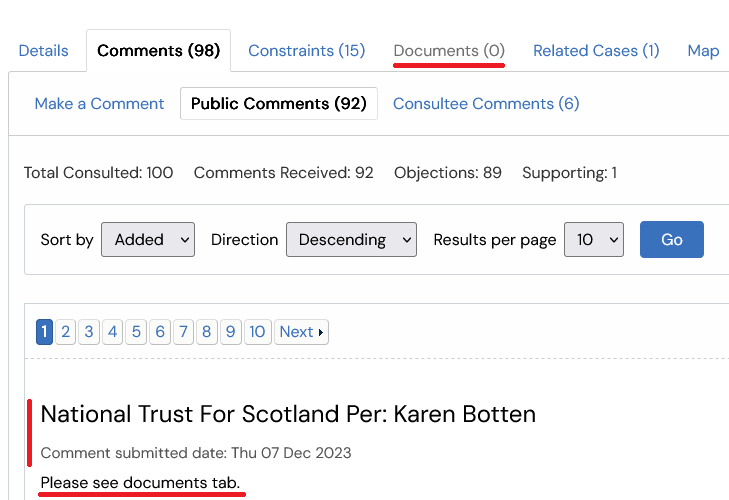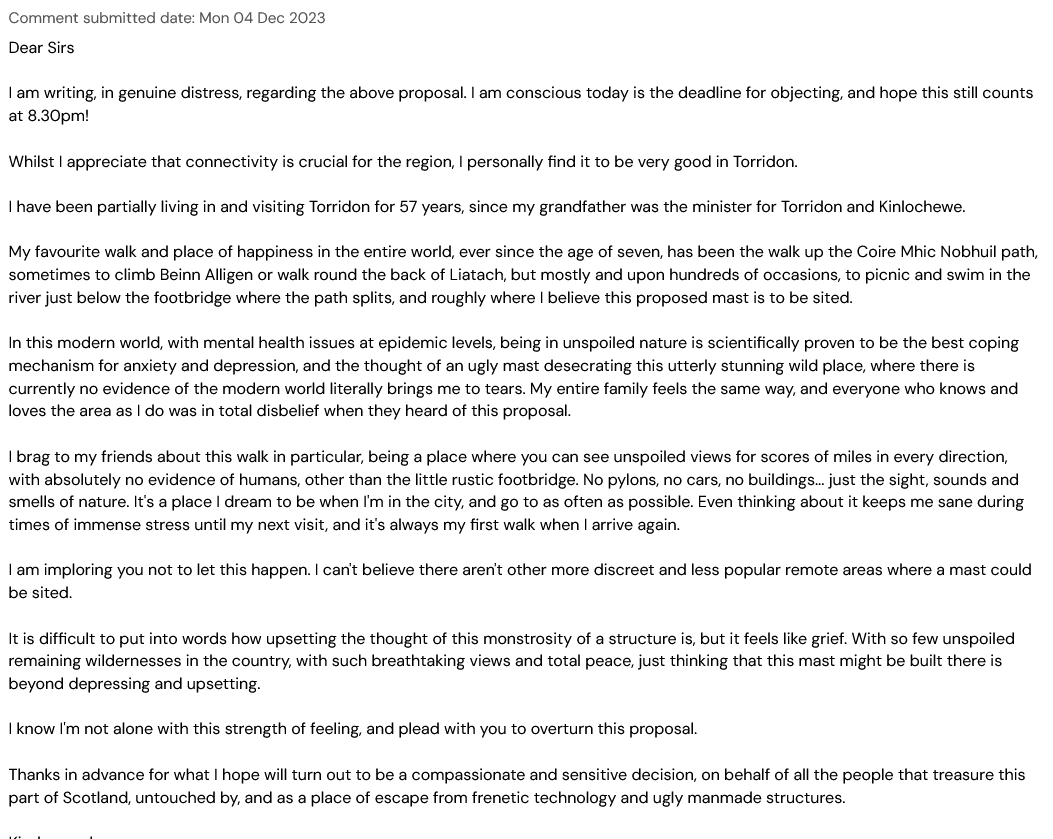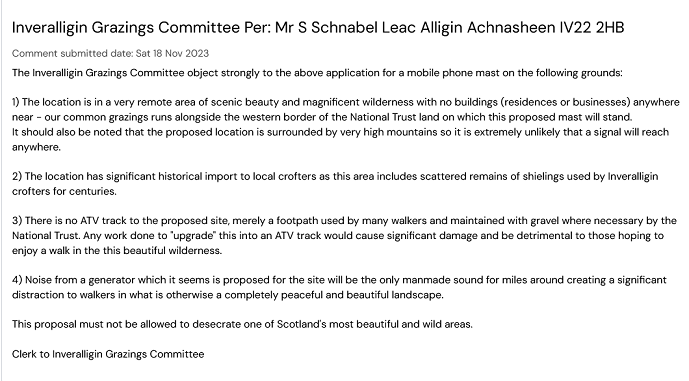On Monday objectors to the proposal to build a telecommunications mast in the heart of Torridon (see here) were informed the application has been withdrawn. A small but significant victory which shows that the roll-out UK Government’s Shared Rural Network programme is far from a foregone conclusion.
There had been 92 comments from the public on the application, almost all objections. On Tuesday all the planning papers for the mast were still on Highland Council’s Planning Portal but when I looked again today they had been removed

While the comments from the public are still on the portal, one wonders for how long? Its not just the planning papers that have been removed, the objection from the landowner, the National Trust for Scotland, and the responses from other statutory consultees have been too.
It should be a matter of matter of public record whether agencies, such as NatureScot, which has statutory responsibility for the landscape, had commented on the application and if so what they had said. The only way to find out now is through an FOI request
This management of the planning system in Scotland, as I have commented before in respect of the Cairngorms National Park (see here), is completely rotten and designed to assist developers. The email I received from Highland Council explains why in a nutshell:
“Should any further application be received for this or a similar proposal, it will be necessary for
you to write in again to advise the Planning Authority of any concerns that you may still have.”
Even if the developer comes back with a proposal for a mast in exactly the same place, objectors to the original application will have to object all over again or their voice will be simply ignored. What this means is that someone is going to have to keep an eye out, perhaps indefinitely, for a new application. There is a similar situation at Luibeg (see here), in the heart of the Cairngorms, where another mast application was withdrawn after a large number of objections were lodged.
This system, in which developers can use the planning system to play cat and mouse with the public, means that protected areas are NEVER safe. If a developer does not at first succeed, the system allows them to try, try, again.
It is time planning law in Scotland was changed so that if a developer decides to withdraw a planning application in the face of objections, the planning authority is forced to take a decision in principle about whether the development proposal was appropriate. If not, further applications should then be barred. That would put an end to the cat and mouse. It would also help create certainty for protected areas in Scotland rather than the constant uncertainty that exists at present.
Or better still, increase the protection of wild land so that such applications, like windfarms in National Parks, are ruled out from the start. The Scottish Government could introduce changes to the planning system as part of its commitment to protect 30% of Scotland for nature by 2030 (its so called 30 x 30 objective).
The implications of the objections for the UK Government’s Shared Rural Network plan
While I have only read, not analysed, the objections to the application, the majority have come from people resident around the shores of Loch Torridon, below where the mast was proposed and the wider local area stretching up to Achnasheen. Not only that but the local objections are generally longer and more fully referenced than the objections from further afield (with quotes for example from NatureScot’s landscape assessment for the Wester Ross National Scenic Area).
Many local objections are also full of passion as this example shows:

All this is brilliant and I would recommend anyone interested in the protection of wild land and landscape in Scotland at the national level to have a read and consider the implications.
In my view the local objections undermine the whole of the UK’s Government’s rationale for extending the Shared Rural Network programme to remote areas. People living around the shores of Loch Torridon already have good mobile coverage in their homes but what they are effectively saying is they don’t need that coverage every time they go out for a walk and they value the landscape more.
Among those local residents are the crofters who have clearly said they value the landscape more than the ability to make a phone call while working on the land:

With the mountaineers who responded to the application saying similar things, public opinion is that there is no case for this mast or similar masts in wild land areas across Scotland.
What this shows is that the Scottish Government needs to start taking a strategic approach to the threats posed by telecommunications masts in wild land rather than sitting on its hands. Among the things it could do now is attempt to engage with the UK Government to amend the Shared Rural Network programme and issue advice to planning authorities that there should be a policy presumption against approving masts in remote areas.
Local people, wild land and Scottish Government control over National Parks
What has happened in Torridon provides good evidence for why the Scottish Government needs to re-think its current proposals to reduce local representation on National Park Boards which it claims will help National Parks focus more on the restoration of nature.
Actually, the Scottish Government has been extraordinarily slow to show any concern, let alone tackle, the reasons why nature in Scotland has collapsed over the last 30 years. A case in point is telecommunications masts where so far Scottish Ministers have been completely silent not just about the implications of the Shared Rural Network programme for wild land but for its 30 x 30 objective (how are bulldozed tracks, diesel generators and masts going to help nature?).
Local people care and usually know far more about such issues than many of the people whom the Scottish Government appoints to Non-Departmental Public Boards. The problem is they usually have almost no power with government in Scotland being among the most centralised in the world. National Parks, where a third of Board Members are locally elected and accountable, provide a small and unique exception. Instead of building on that and democratising our National Parks further (eg by removing the first past the post system for electing such members) to strengthen local voices and local participation in decision–making, the Scottish Government want to do the opposite. In my view that will make our National Parks even less effective than they are now.

Two more of these ‘not-spot’ masts appear set to happen on wild unpopulated land … Both on designated local areas of outstanding natural beauty.
One 25 mtr lattice mast planned for 2.5 km up Glen Moidart with “ancillary works” (well beyond where anyone now lives). See Highland council (THC) planning portal 23/01466/TPNO. withdrawn on 20th November.
BUT
Another planned for 3.5km NW of Glenbeg Cottage, Glen More, complete with hardstanding, access track, compound and ancillary development . see THC portal 13/04646/FUL .https://wam.highland.gov.uk/wam/files/C1FF9F8F3607FB2BB64FF6A9805FB9DA/pdf/23_04646_FUL-LOCATION_PLAN-3135255.pdf,
This location is a ridge top not so far from a third mast, (decided ) next to an existing forestry track near Achateny, full consent was given for this one back February. No one lives in line of sight near there either.
Gradually our remaining wild land is to be dug up and commercialised for no valid local advantage.
Well-informed and useful post, Nick. A key point is that there IS no rationale for the TNS element of SRN. This is the 100% funded element of SRN, with 320 sites in Scotland designated by Ofcom using ‘radio software’. These sites are required to be in TNS areas, avoiding areas of partial coverage. They are explicitly NOT sited to help communities or public road users – and by design they avoid them. The ‘rationale’ is to to bring 4G coverage to as much new land area as possible. A network of masts is to be built to ‘tame’ these white spaces by bringing them the ‘benefit’ of 4G. The (colonial) designers think that white spaces are evidence of ‘market failure’, that 4G is a Good Thing which justifies itself. They have no conception of preserving ANY areas from human activity, or of ‘Wild Land’ as a national asset, valued for its wildness.
These areas are uninhabited, so there is no-one to notice or object. Some in well-known places like Torridon and Cairngorm, attract attention and objections, but these are the tip of a systematic plan to tame (vandalise) all wild land.
What other ‘improvements’ may follow? Why should these sites not offer USB charging points, or defibrillators. The access tracks could allow wheelchair access. ‘The future is bright, the future is Orange’ .
Rationale for the SRN scheme, from the horse’s mouth:
“SRN Info info@dmsluk.com Sent: Friday, 12 Jan, 24
Even in areas where there are no premises, it is still essential to provide improved connectivity. Having the ability to access vital information and services is critical, as is the reassurance of being connected if there is an incident in these harder to reach places.”
So there you have it. The scheme is ‘essential’, as deemed by the SRN office in The Shard. No need to ask anyone or consult with communities, stakeholders, or suchlike green crap.